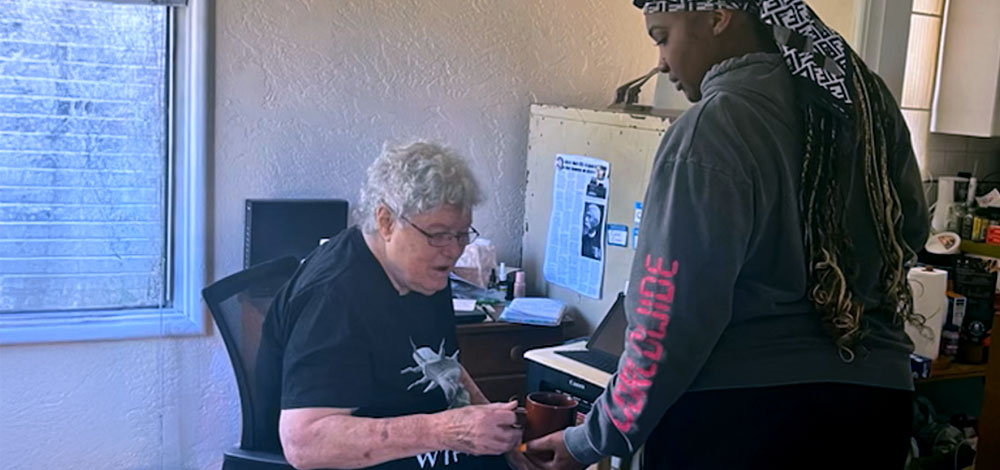|
Getting your Trinity Audio player ready…
|

In May 2022, Linda’s elderly mother was admitted to a small assisted living community in San Diego. In many ways, it was a dream come true. It was cozy, with just six beds, and located in the same part of the city where her 91-year-old mother, an immigrant not fluent in English, had resided for decades. Exhausted by the lengthy process of finding a suitable facility, Linda felt immense relief when her mother finally moved into the new care home. “I literally fell to my knees in gratitude,” Linda said.
That consolation came at a high price. Each month, Linda’s mother paid $5,500 for room, board, and basic nursing services. The expense was a reach, and Linda’s mother sometimes needed financial assistance from friends and family. Still, it felt worthwhile. According to Linda, whose last name is being withheld to protect her family’s privacy, the facility administrator had promised that once her mother qualified for Medi-Cal’s Assisted Living Waiver program, she would be able to remain while paying a much lower, government-negotiated monthly rate (PDF) for room and board.
However, when Linda’s mother was accepted into the waiver program in January, the administrator said they no longer had discounted beds available. Her mother, unable to afford the unsubsidized commercial rate, was evicted.
Many seniors and people with disabilities prefer the independence and social opportunities offered by assisted living communities over nursing homes. But assisted living communities are expensive, and federal Medicaid requirements do not mandate the coverage of care delivered in such settings, which are not considered medical institutions. Facing high demand, California and other states have opted to create their own coverage options to enable enrollees to receive assisted living benefits through state-run health insurance plans.
Justice in Aging: An Equity Analysis of California’s Assisted Living Waiver
At some point over their lifetimes, most aging adults and adults with disabilities will require assistance to remain in their homes and communities. And yet, many Californians report that their long-term care needs are unmet. What’s more, access to care is unequal and uneven across demographic groups.
As California continues to make investments in its long-term care system, inequities are likely to persist if the state does not take intentional steps to make equity a primary focus in its efforts to expand the availability of at-home care.
To address these concerns, Justice in Aging conducted an equity analysis (PDF) of California’s Assisted Living Waiver using its recently released Equity Framework for California’s Medi-Cal Home and Community-Based Services Programs. The CHCF-supported paper and accompanying webinar describe Justice in Aging’s equity framework, including its five domains where inequities can arise; summarize how inequities emerge in the Assisted Living Waiver; and put forward recommendations for addressing inequities through the state’s current efforts to update the Assisted Living Waiver.
This paper will be of special interest to state agencies, policymakers, and aging and disability providers and advocates working toward an inclusive, equitable home-and-community-based system that supports the right of older adults and people with disabilities — both of whom have low incomes — to live in the setting of their choice.
The Assisted Living Waiver (ALW) program run by Medi-Cal, California’s Medicaid program, is one such innovation. Through it, Californians who are enrolled in full scope Medi-Cal can access coverage for care and services provided in assisted living settings. While Medi-Cal picks up the majority of the bill, waiver program participants must continue to pay room and board out of pocket. Those monthly fees are capped at $1,325 for those who receive Supplementary Security Income program (SSI) benefits, and capped at $1,345 for those whose income exceeds $1,492 per month — the maximum that SSI will provide to an individual.
Under the program, the assisted living organization collects between $2,658 and $4,988 per month from Medi-Cal based on the care needs of the participant. For example, a facility caring for someone living with cognitive impairment who needs light supervision and prompting to eat and take medications would get a lower Medi-Cal payment than would a facility caring for a wheelchair user needing daily assistance with feeding, dressing, and bathing.
The program, however, is only available in 15 of the state’s 58 counties, open spots are limited, and long waitlists mean years can go by before a person can move into a facility. Those delays and uncertainties can cause emotional and financial stress for Medi-Cal enrollees and their caregivers. Moreover, assisted living facilities are not required to accept ALW enrollees, despite what they may have informally communicated to a prospective resident. This leaves families vulnerable to eviction.
Management “was made aware of my mom’s desire and plans to transition into the Assisted Living Waiver program as soon as she qualified,” said Linda. She said the manager implied that her mother would have a guaranteed ALW spot. “We were led to believe [they] would transition and accept my mom under the ALW program, and that the $5,500 monthly payment included holding the ALW space,” she said.
The assisted living community asserts that it made no such pledge. “While we strive to accommodate as many program participants as possible, we cannot guarantee space for every individual transitioning to the ALW program,” said the facility administrator, noting that the admissions agreement clearly delineates those limitations.
Assisted living facilities trying to win clients frequently make informal verbal promises that go beyond what they guarantee on paper, according to Pauline Shatara, MA, deputy director of California Advocates for Nursing Home Reform (CANHR). Shatara, whose organization helps operate a helpline for people like Linda who struggle to navigate the nuances of assisted living under Medi-Cal, said that families have few options for recourse if a verbal promise is broken.
Unless it is explicitly written into an admissions agreement, “nothing says a facility can’t” evict an ALW participant who can’t pay the commercial rate, said Shatara. “They aren’t committed to providing a certain number of [ALW] beds.”
“I feel scammed,” said Linda, whose mother depleted her entire $44,000 nest egg on the self-pay rates while waiting for ALW benefits to kick in. Had she known there was no bed guaranteed for her mother at the waiver program’s lower rate, she would not have arranged to move her into that community, Linda said.
Struggling with Rising Demand
California’s ALW launched in 2009 and has been renewed every five years as a waiver program. To be eligible, a Medi-Cal enrollee must have needs sufficient to qualify for nursing home care. A key ALW goal is to rebalance the number of seniors and people with disabilities who reside in nursing homes. Nursing home care costs the state substantially more per capita than assisted living and is often not the preferred care setting for people able to function in a more independent setting with the right support.
Nursing homes are often larger and less personal than assisted living facilities, which are typically smaller and more home-like. “That’s a big difference for your quality of life,” said Kim Selfon, a policy specialist for Bet Tzedek, a Los Angeles-based legal services agency.
The attractive features of assisted living facilities — namely day-to-day support paired with a degree of independence — have led thousands of Medi-Cal enrollees to sign up for the ALW program. Its popularity meant that demand quickly surpassed the maximum program limit of 5,744 participants that was in place from 2009 to 2022. Beginning in late 2021, the waitlist ballooned to over 7,000 (PDF).
Recently, with an injection of federal funding for home and community-based services related to the American Rescue Plan Act, the state raised that limit to 12,744 to eliminate the waitlist. “If you think about California, that’s not that much,” said Hagar Dickman, JD, a senior attorney with Justice in Aging, a nonprofit legal advocacy organization that fights senior poverty, pointing to the small fraction of the state’s population that can access the program.
“The waitlists are a barrier to care,” said Eileen Koons, MSW, who directs Huntington Hospital Senior Care Network, one of the 31 regional care coordination agencies contracted to manage enrollment and waitlists for the state. Staffed by nurses and social workers, the agencies assist with applications, vet applicants’ care needs, monitor waitlists, and place people in one of the over 800 ALW-participating communities.
Because of regional inconsistencies in demand, waitlists vary widely, fueling geographic and racial inequities. In 2022, NorCal Care Agency, which serves the San Francisco Bay Area, had a waitlist of 929 people. Universal Home Care, based in Beverly Hills, had a waitlist of one.
Depending on location, applicants may be “waiting a really, really long time,” Dickman said.
Difficulty Navigating and Accessing Care
The ALW waitlist process can be opaque and uncertain, especially since the waitlist is not first come, first served, and prioritization for making it off the list is typically based on the urgency of individual cases. As well, ALW participants require a high level of care, and those awaiting admission must make alternate arrangements, either by paying for care in their home or at an assisted living facility, finding a family member who can care for them, or entering a nursing home in the interim.
“If you don’t have a family member to provide 24-hour care and can’t afford [to pay out of pocket], what’s going to happen to you?” Selfon wondered aloud, explaining that a person will likely move into a nursing home while they wait.
Because obtaining an assisted living spot can be competitive, those with savings or family members who can provide financial assistance might choose to move into an assisted living facility before ALW has kicked in, especially if an organization says they can remain where they are once accepted into the waiver program. Some people’s savings run out before an ALW slot opens.
“One family member told me that he completely drew down his entire savings account for three years of his mother being in assisted living while being on the ALW waitlist,” said Leigh Milhorn, RN, MSN, supervisor of community nursing for Huntington Health’s Senior Care Network.
Once accepted for the ALW, a person has 60 days to move into a suitable community that accepts the lower ALW rate. That can be a difficult deadline to meet, Koons said. “You’re talking about completely upending a person’s life,” she said.
Big cities present special challenges for ALW participants. “In core urban markets, where real estate is more expensive, facilities tend to be less inclined to participate in the Assisted Living Waiver,” said George Kuntnerian, MBA, MS, a senior executive at 6beds, a residential care advocacy organization. The DHCS reimbursement rates for facilities are divided into five tiers based on level of care (PDF) and are not adjusted for geographic cost-of-living differences.
The California Department of Health Care Services (DHCS), which runs Medi-Cal, acknowledges that the state’s cost-of-living crisis has limited the number of ALW beds available, with some providers leaving the program. “Facility provider participation in ALW is voluntary,” said Anthony Cava, a DHCS spokesman. “Inflation and increased cost of living across the state have discouraged some providers from participating in ALW, leading to a lack of available beds.”
Growing Need, Emerging Opportunities
Recent and forthcoming initiatives at the state level give hope to those who aim to improve access to assisted living for Californians on Medi-Cal, however. For instance, when DHCS added 7,000 slots to the waiver program in 2022, effectively clearing the waitlist and substantially raising the program cap, the results were felt immediately. In March 2023, the waitlist declined from 7,300 a year ago to 3,300 (PDF).
While officials celebrate the shorter waitlist, they acknowledge that barriers remain.
“DHCS continues to grow the program, and awareness and interest have increased,” said Cava. “However, even with increased awareness, the biggest challenge faced by the ALW is that the number of applicants far exceeds the amount of available beds.”
DHCS has indicated plans to merge the ALW with the Home and Community-Based Alternatives waiver, which provides care management services to people at risk for nursing home or institutional placement, allowing them to stay in their homes or in an alternative community setting. The intent of this merger includes streamlining operations and making the ALW available statewide, but it is unclear what impact the merger would have on the existing challenges to the ALW program.
“There were still a lot of unanswered questions about how the current application and assessment process would be improved, how they would identify which counties would be expanded first, how to ensure quality of the providers through oversight, and how to protect participant rights,” Shatara said.
Furthermore, Medi-Cal is phasing out its asset limit (PDF) for adults over age 65, people who have disabilities, and people who live in long-term care facilities. Historically, the asset limit restricted enrollment for these groups to individuals with over $2,000 in assets and couples with over $3,000. In July 2022, the asset cap was raised to $130,000 for one person and an additional $65,000 for each additional household member, and in 2024, the requirement will be eliminated altogether. This means even more Californians — as many as 20,000 — will be eligible for the ALW program.
Challenges for Caregivers
As a result, some warn that the waitlist will not be cleared for long. As California’s demographic profile rapidly skews older and Medi-Cal eligibility becomes more inclusive, demand for ALW enrollment will continue to grow, said Kuntnerian.
Finally, under California Advancing and Innovating Medi-Cal (CalAIM), a multi-year initiative for a more person-centered Medi-Cal program, DHCS is creating new opportunities for Californians who may benefit from assisted living through Community Supports. One of them will help people move from nursing homes to assisted living facilities (PDF) as well as help prevent avoidable admissions to nursing homes. Another program, Respite Services (PDF), will provide relief and assistance to caregivers like Linda. Both will help more Californians remain in their communities.
In San Diego, Linda expressed hope that her family’s story will help others navigate the program’s complexities as well as understand the risks that assisted living residents with lower incomes can face. “I hope word gets out to fellow caregivers to be diligent,” she said. “The more I can share this with people, it makes it worthwhile.”
When her mother was evicted, it took Linda weeks to find a new assisted living community that she found acceptable and that would admit her mother under the waiver program. For a time, Linda was concerned that her only option would be for her mother to move in with her, a situation that she was not prepared for. “I was really distressed,” she said. “I work full-time. It’s just really difficult.”
Now, Linda feels fortunate that her mother is comfortable at her new residence. “The home is really beautiful,” she said, noting that the ratio of two caregivers per resident is the best Linda has seen so far. And perhaps most importantly for Linda, her mother says she’s happy. “It worked out for my mom. She’s in a better place,” said Linda.
But the family has had to make sacrifices to make it work. While the previous facility had been centrally located and in a familiar neighborhood, her mother’s new home is a substantial commute away. “There was a price to pay to get her there,” Linda said. “It’s far out.”
Yet facing new challenges is just part of being a caregiver, she said. “Unless you walk in a caregiver’s shoes, you can’t imagine.”
Authors & Contributors

Robin Buller
Robin Buller is an Oakland-based writer, researcher, and editor. She has reported on harm reduction, maternal health, migration, housing, and policing for The Guardian, The Oaklandside, and other publications.
Originally from Canada, she holds a doctorate in history from UNC Chapel Hill and has lived in California since 2018.

Carolyn Fong
Carolyn Fong is a commercial, editorial, brand, and portrait photographer working throughout the San Francisco Bay Area. She specializes in imagery that celebrates the craft, the people, and the spaces that create community. She earned a Bachelor of Fine Arts in photography and imaging from the Art Center College of Design in Pasadena, California, and has practiced photography since 2005. Fong is a proud member of two important organizations, Diversify Photo and Women Photograph.




